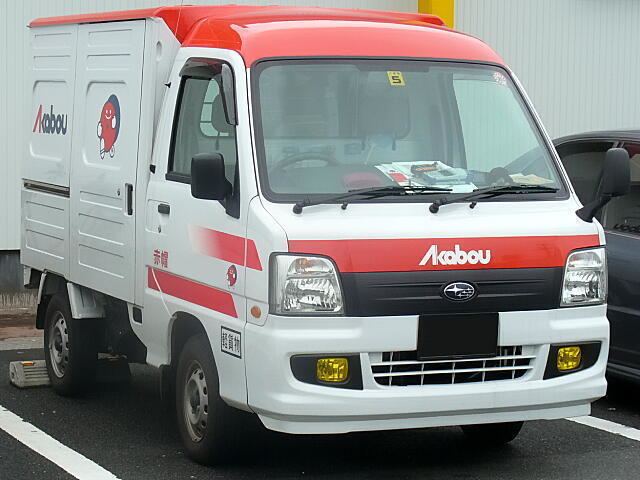 | ||
A Kei truck, or Kei class truck, or Japanese mini truck is a minitruck, a tiny but practical pickup truck available in RWD or 4WD version, built to satisfy the Japanese keijidōsha (軽自動車, "light vehicle") statutory class. They are known as Keitora (軽トラ, "light truck") in Japan alongside the microvan.
Contents
Design
The Kei truck class specifies a maximum size and displacement, greatly increased since legislation first enabled the type in 1949. They evolved from earlier three-wheeled trucks based on motorcycles with a small load carrying area, called miwa (三輪), which were popular in Japan before the war. The 1998 law admits a maximum length of 3.4 m (134 in), a maximum width of 1.48 m (58 in) and a maximum height of 2.0 m (79 in) with a maximum displacement of 660 cc. They weigh about 700 kg (1,500 lb), and when ungoverned can reach up to 120 km/h (75 mph). Due to the limits established with regards to vehicle length, most, if not all, current trucks in this classification are built with the "cab over" approach to maximize load-carrying abilities. For export markets, Kei trucks are usually fitted with bigger engines to allow them more useful carrying capabilities. An Indonesian version of the originally 543 cc Suzuki Carry is currently built with a 1.6-liter unit – nearly three times larger.
Typical manufacturers and model names include: Subaru Sambar, Suzuki Carry, Honda Acty, Mazda / Autozam Scrum, Mitsubishi Minicab, and Daihatsu Hijet. The first model to be sold in Japan was in 1959, called the Kurogane Baby until 1962.
Many of these have been produced under license abroad, such as the Piaggio Porter. In South Korea, Daewoo and Asia (Kia) produced rebadged Suzuki Carry/Every and Daihatsu Hijet Van as Daewoo Labo/Damas, and the Asia/Kia Towner.
Uses
Widely employed throughout Asia in agriculture, fisheries, construction and even for firefighting, used models have appeared in the US for off-road use typically by farmers and hunters. Japanese laws encourage surplussing vehicles after a relatively short life; consequently importers bring used Kei trucks into the US by the container load for sale at prices ranging from US$1,000 to $12,000. They have fully enclosed cabs, seat belts, windshield wipers, AM radios, heaters, lights, and signals, and are claimed to run 64 km (40 mi) on one US gallon of gasoline. They generally have 1.8 m (6 ft) long pickup beds with fold-down sides; dump and scissor lift beds are also available as well as van bodies. The length limitation forces all of these models into a cab forward design.
While street legal in Japan, Kei trucks lack proof of conformance with North American regulations. Nevertheless, they are approved for use on local roads in several states in the United States. Many are also used as campus maintenance vehicles, rarely leaving campus confines. State legislation passed during 2008 in Oklahoma and Louisiana are the most liberal, prohibiting their use only on interstate highways. Kei vehicles older than 25 years may be imported into the US with very few restrictions.
